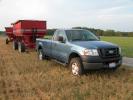Quote:
Originally Posted by CapriRacer

which may mean the speedometer is calibrated to actual circumference and internally compensates for that 3%. Other vehicles may not do that!
|
Not quite sure what you mean here, Capri. Would you clarify, please?
How i measured circumference, by the way, is by marking the tire and the pavement, rolling forward one revolution and measuring the distance on the pavement (garage floor, actually). The programmer allows for increments as small as 1mm. I don't know that the programmer or the truck's PCM does any internal compensating, hence my query above, but I happen to know the designer of the programmer, so I can ask.
The other thing is that tires tend to expand a little from centrifugal force at speed. It caries from tire to tire, I guess, but even I'm not THAT pedantic! If there is a rule of thumb, I'd like to know what it is.
__________________
Jim Allen
The Frugal Four Wheeler and Farmer
My ultimate goal is not necessarily the highest mpg but to make my trucks more efficient configured as I need them.
Old Reliable '86 Ford F-250HD 4x4, 6.9L diesel
Red '00 Honda Accord Coupe, 3.0L V6, automatic
The Plugger '05 Ford F-150HD 4x4, Regular Cab, 8-ft bed, 8,200# GVW, 5.4L V8, automatic, 4.10:1 ratios, 285/70R-17D tires
